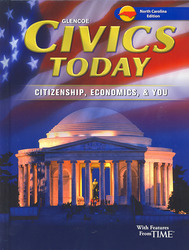

Civics Today: Citizenship, Economics & You © 2008Chapter 13: North Carolina State GovernmentChapter OverviewsThe Constitution of North Carolina outlines the organization of the branches of state government, the powers and terms of various offices, and the method of election for state officials. North Carolina's state government has the same three-part structure as the U.S. government: legislative, executive, and judicial branches. The purpose of the General Assembly, the North Carolina legislative branch, is to create new laws for the state. In structure and operation, the General Assembly is very similar to the U.S. Congress. The governor acts as the chief executive of North Carolina and carries out the laws passed by the General Assembly. The executive branch is more than just the governor, however. Many other department heads and government officials in the executive branch help carry out North Carolina state policy. The state judicial branch resolves civil and criminal disputes between North Carolina citizens and also acts as a check on the power of the state legislature and state executives. District courts deal with many aspects of North Carolina law. The North Carolina Supreme Court acts as the final point of appeal within the court system. |  |















